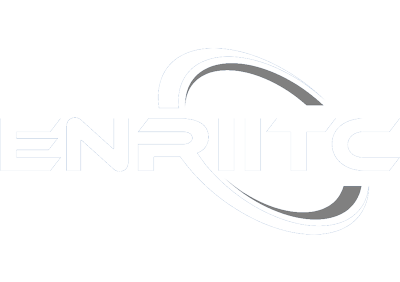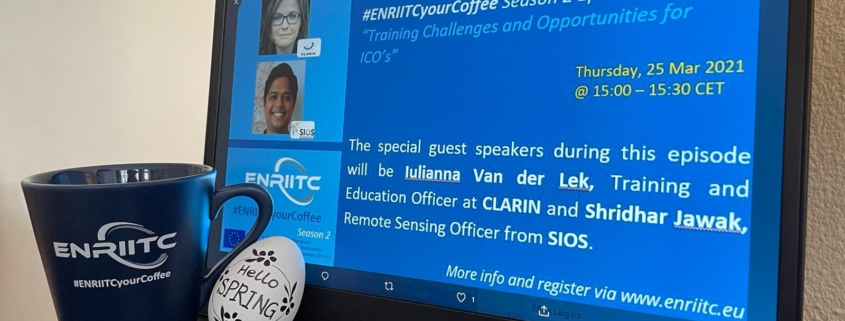#ENRIITCyourCoffee Season 2: Episode 9 “Training Challenges and Opportunities for ICO’s”
Welcome to the recap of the last #ENRIITCyourCoffee before we break for Easter. The invited speakers were Iulianna van der Lek, Training and Education Officer at Common Language Resources and Technology Infrastructure (CLARIN) and Shridhar Jawak, Remote Sensing Officer at Svalbard Integrated Earth Observing System (SIOS). The discussion was lead by Marco Galeotti, Communication Officer at the European Multidisciplinary Seafloor and water column Observatory (EMSO).
Iulianna started with an introduction of CLARIN and its distributed connected data centres all over Europe. Since CLARIN has adopted the Open Science politics policy of the European Comission all integrated data sets are available in open access, not only for researchers but also for the citizens. She mentions that this aspect might make industry collaboration more difficult. Iulianna emphasises how CLARIN closely cooperates with innovation projects and in the cultural sector:
“We collaborate with galleries, libraries, archives and museums. And we need to ICOs to support us enhance the collaboration with the industry or non-academic partners.”
While CLARIN does not have a full-time ICO in the central office, but other staff members cover these tasks such as Technology Transfer Officer and collaboration of course is still ongoing. Most often these are one off projects or ongoing depends from case to case. Iulianna pointed out how there are many valuable skills for ICOs, but most important core skill is the ability to translate the value of the research infrastructure (RI) to the industry, and help develop a strategic knowledge and technology transfer plan. Of course, it’s also very important to know the data industry and have the ability to identify the gaps, that we could fill in.
“I think for a distributed RI, it’s very important that we come up with a developed and effective model for collaboration between the ICO and different nodes. This is one of the most important aspects or training topics, and we hope that ENRIITC and also other European partners, would help provide this type of training.”
After Iulianna’s great presentation, Shridhar Jawak from SIOS took us to the as north as #ENRIITCyourCoffe has possibly reached – Svalbard. SIOS focuses on the processes and interactions between the different spheres in and around Svalbard. The main activity is systematic observation, which is stable over time yet dynamic as new questions from the society arise. SIOS consists of 3 main sections:
- Observing System, which is based on the scientific observations on site and the remotely sensed.
- Consortium, which consists of 24 institutions from nine countries who have active RI in and around Svalbard.
- Knowledge Center, which consists of five people who coordinate, develop and optimise the distributed RIs.
SIOS has different services like data management, logistics access program and the remote sensing resources. Shridhar takes care of the remote sensing services. He draws a comparison with CLARIN as they also don’t have a full-time ICO, but they distribute the tasks.
Shridhar mentions that Svalbard is a great place for research because it is High Artic with large temperature gradients and also influenced by water and air currents, in addition to a unique geographical position to use satellite data. SIOS also plays an active role in the European landscape of environmental RI.
Additionally, SIOS tries to engage industry with conferences, workshops, trainings with experts and other events to bring researchers, policymakers and industry together. A big driver for innovation in SIOS’ perspective is the changing climate and the global need to adapt to it in the future. This is especially sharply felt in Svalbard.
In the challenges section, Shridhar emphasised the difference of funding in RIs and industry. He felt like connecting these two models would lead to the most success in facilitating dialogue between the parties. Shridhar shared their experience, that firstly, workshops and conferences are very effective platforms to bring industry and researchers together. The key there being a well-crafted topic of interest. Secondly, access to research is important to drive the collaboration. Lastly, SIOS is going to launch the Science Innovation award, which will be open for both industry and research community and will provide new opportunities for industries to prove their technologies in Arctic scenarios and vice versa.
As soon as Shridhar’s presentation was over, a question arose as an extension about his last point: the Science Innovation Award – who, how and what? This was posed by our speaker in a previous #ENRIITCyourCoffee session Ilaria Nardello. Shridhar replied, that while the team in SIOS is still developing the concept, the basic idea is to also fund the proof of concept of technology, that can be implemented in the Arctic. But he teased that more will be clear in the coming months.
Next up was a question for Iulianna, which seems to be a part of every topic at every coffee session: who owns the intellectual property? In this case more between the CLARIN central management and the nodes. Iulianna answered that each node has the freedom to set up their own projects with industry. “We can exchange experiences and best practices, but we don’t really interfere in their projects. Of course, we will take the responsibility to coordinate this as much as possible and work in a united manner.” Additionally, she expressed excitement to be a part of ENRIITC since collaboration will help them develop their ICO profile and strategy. Regarding the next follow-up on ILOs, Iulianna specified that CLARIN has only ICOs because the industry is one of the users for their services, language technologies and resources.
Jorge Lopez addressed the next question to Iulianna about the effective model of collaboration that was mentioned in her slides. Iulianna elaborated that the model is under development and they are currently at a survey phase to pinpoint the industry collaboration activities in the nodes. She emphasised that they are still working on it since only four of the 23 members have information on ICOs present on their website. Further on, Jorge followed up with a question on the importance of technological knowledge on ICOs, which is also a returning topic at our coffees. Iulianna referred to the survey, which identified that there is little training happening on the topics of language data standards and repositories. She pointed out that this is essential for industry since mostly academia develops such repositories and a good basis for collaboration.
This was followed by a question on gendered language and if there are current collaborations on that. Iulianna’s colleague Elisa added, that there is indeed a project detecting gender biased language in parliamentary speeches and she expressed that this knowledge can easily be applied in a different field.
Next the topic shifted to IPR rules for publicly funded research work results, driven by a question from Ed Mitchell. This developed to a nice exchange of ideas and questions from several institutions, who all aimed to work on bettering this area and building on each other’s knowledge. You have the chance to listen the entire topic from 30:49 in the recording below.
We will retire our coffee briefly for Easter, but you are welcome to join the conversation on our LinkedIn group here. See you on Thursday, 8 April 2021 from 15:00 – 15:30 CET where the discussion on Open Data Resources will be led by Ilaria Nardello, Research Associate at SZN with Katharina Lauer the Industry officer at ELIXIR. Registration is open here.






Leave a Reply
Want to join the discussion?Feel free to contribute!